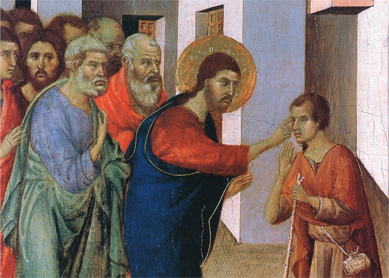Many religious stories are built around the manifestation on earth of divine power in some form (a miracle, a healing, a special blessing).
In a dramatic act of healing, Jesus puts saliva on a blind man’s eyes and restores his sight (Mark 8:22-26). This story echoes John 9:6, where Jesus mixes his saliva with dirt and then applies it to the eyes of a blind man. Modern readers have classified these actions in a variety of ways, ranging from magic to folk medicine. No doubt ancient readers also varied in their understandings.
In the ancient world, many physical objects were thought to be conduits of power, both natural and divine. Saliva was widely used in the ancient world for healing. The Roman writer Pliny (23-79 C.E.) states that saliva has a natural ability to counteract snakebites and saliva from a fasting person is especially efficacious (Natural History 7.125). For Pliny, the power in saliva is an expression of the divine status of the cosmos and everything in it. Saliva then takes its place among many items from nature that have special powers: certain plants, animals and human body parts including bones of the untimely dead, earwax, menstrual blood, gallstones, and teeth. In the modern world, plant extracts are still thought to be effective, and blood transfusions are common.
The anecdotes in Mark and John include the use of saliva but emphasize the divine status of the healer, not the power of the natural world. John explains, “If he were not from God, he would not be able to do these things” (John 9:33). The power of saliva is less important than the divine status of the healer. The scholar J. Z. Smith has argued that a basic component of many ancient claims to healing power is a seemingly direct genealogical or personal relation to a deity or goddess.
Mark 8 provides its own interpretation of the healing by combining Jesus’ application of saliva with his laying on of hands. This is confirmed in that the laying-on of hands is repeated a second time in verse 25 without any use of saliva. Jesus’ hand—that is, Jesus himself—conveys divine power through touch. Nothing else is needed. Once again, it is Jesus’ status that is of interest in the story. Jesus does not need props of any kind to supplement his power. The superiority of his laying-on of hands is made clearer by the repetition of the action, the first time demonstrating his power to use saliva and then trumping that with an even greater show of power. Jesus is able to put divine power into action simply by speaking, going beyond even the powerful use of animal, plant, and human props.
This power is reminiscent of blessings and curses in the Hebrew Scriptures, types of speech spoken by the deity through an earthly representative. In the story of the fig tree (Mark 11:12-14), Jesus curses a fig tree, stating, “May no one ever eat fruit from you again” (Mark 11:14). Jesus stands above the world of nature with a power that affects the tree and establishes him as a representative of divine power. Jesus’ powerful speech is an opportunity to stress to his disciples that their faith in God will bring the same type of divine power into their lives: their prayers will be answered, manifesting both their faith and God’s power.
Differing views existed in the ancient world about the best methods for healing people; Mark 8 presents the view that speech alone can embody divine power and heal people as long as the speaker has a direct connection with divinity.



